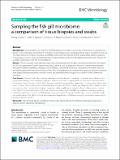Files in this item
Sampling the fish gill microbiome : a comparison of tissue biopsies and swabs
Item metadata
| dc.contributor.author | Clinton, Morag | |
| dc.contributor.author | Wyness, Adam J. | |
| dc.contributor.author | Martin, Samuel A. M. | |
| dc.contributor.author | Brierley, Andrew S. | |
| dc.contributor.author | Ferrier, David E. K. | |
| dc.date.accessioned | 2021-11-10T15:30:06Z | |
| dc.date.available | 2021-11-10T15:30:06Z | |
| dc.date.issued | 2021-11-10 | |
| dc.identifier | 276648351 | |
| dc.identifier | dbe5ec77-caa1-4ecf-8d90-89fde7b6894f | |
| dc.identifier | 85118780339 | |
| dc.identifier | 000716926800001 | |
| dc.identifier.citation | Clinton , M , Wyness , A J , Martin , S A M , Brierley , A S & Ferrier , D E K 2021 , ' Sampling the fish gill microbiome : a comparison of tissue biopsies and swabs ' , BMC Microbiology , vol. 21 , 313 . https://doi.org/10.1186/s12866-021-02374-0 | en |
| dc.identifier.issn | 1471-2180 | |
| dc.identifier.other | RIS: urn:06C0736466BB7685B66550F41B817927 | |
| dc.identifier.other | RIS: Clinton2021 | |
| dc.identifier.other | ORCID: /0000-0003-3247-6233/work/103137339 | |
| dc.identifier.other | ORCID: /0000-0002-6438-6892/work/103137544 | |
| dc.identifier.uri | https://hdl.handle.net/10023/24307 | |
| dc.description | Funding: The research costs of this work were supported by the BBSRC EASTBIO DTP and Marine Alliance for Science and Technology Scotland (MASTS) small grants funding scheme. | en |
| dc.description.abstract | Background: Understanding the influence of methodology on results is an essential consideration in experimental design. In the expanding field of fish microbiology, many best practices and targeted techniques remain to be refined. This study aimed to compare microbial assemblages obtained from Atlantic salmon (Salmo salar) gills by swabbing versus biopsy excision. Results demonstrate the variation introduced by altered sampling strategies and enhance the available knowledge of the fish gill microbiome. Results: The microbiome was sampled using swabs and biopsies from fish gills, with identical treatment of samples for 16S next generation Illumina sequencing. Results show a clear divergence in microbial communities obtained through the different sampling strategies, with swabbing consistently isolating a more diverse microbial consortia, and suffering less from the technical issue of host DNA contamination associated with biopsy use. Sequencing results from biopsy-derived extractions, however, hint at the potential for more cryptic localisation of some community members. Conclusions: Overall, results demonstrate a divergence in the obtained microbial community when different sampling methodology is used. Swabbing appears a superior method for sampling the microbiota of mucosal surfaces for broad ecological research in fish, whilst biopsies might be best applied in exploration of communities beyond the reach of swabs, such as sub-surface and intracellular microbes, as well as in pathogen diagnosis. Most studies on the external microbial communities of aquatic organisms utilise swabbing for sample collection, likely due to convenience. Much of the ultrastructure of gill tissue in live fish is, however, potentially inaccessible to swabbing, meaning swabbing might fail to capture the full diversity of gill microbiota. This work therefore also provides valuable insight into partitioning of the gill microbiota, informing varied applications of different sampling methods in experimental design for future research. | |
| dc.format.extent | 15 | |
| dc.format.extent | 1500005 | |
| dc.language.iso | eng | |
| dc.relation.ispartof | BMC Microbiology | en |
| dc.subject | Veterinary microbiology | en |
| dc.subject | Experimental design | en |
| dc.subject | Sampling methodology | en |
| dc.subject | Gill microbiota | en |
| dc.subject | Microbial assemblages | en |
| dc.subject | Aquaculture | en |
| dc.subject | Atlantic salmon | en |
| dc.subject | GC Oceanography | en |
| dc.subject | QR Microbiology | en |
| dc.subject | SH Aquaculture. Fisheries. Angling | en |
| dc.subject | DAS | en |
| dc.subject.lcc | GC | en |
| dc.subject.lcc | QR | en |
| dc.subject.lcc | SH | en |
| dc.title | Sampling the fish gill microbiome : a comparison of tissue biopsies and swabs | en |
| dc.type | Journal article | en |
| dc.contributor.institution | University of St Andrews. School of Biology | en |
| dc.contributor.institution | University of St Andrews. Scottish Oceans Institute | en |
| dc.contributor.institution | University of St Andrews. Centre for Research into Ecological & Environmental Modelling | en |
| dc.contributor.institution | University of St Andrews. Pelagic Ecology Research Group | en |
| dc.contributor.institution | University of St Andrews. Marine Alliance for Science & Technology Scotland | en |
| dc.contributor.institution | University of St Andrews. St Andrews Bioinformatics Unit | en |
| dc.contributor.institution | University of St Andrews. Centre for Biophotonics | en |
| dc.identifier.doi | 10.1186/s12866-021-02374-0 | |
| dc.description.status | Peer reviewed | en |
This item appears in the following Collection(s)
Items in the St Andrews Research Repository are protected by copyright, with all rights reserved, unless otherwise indicated.

